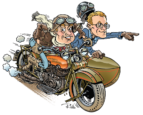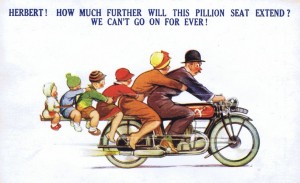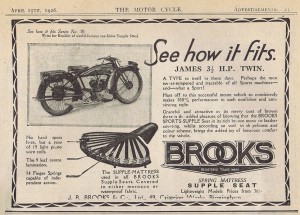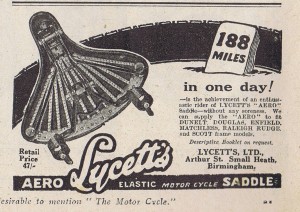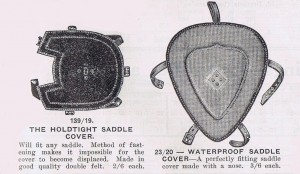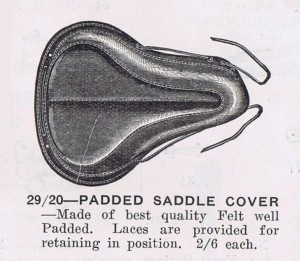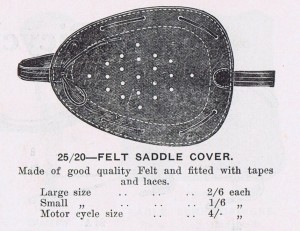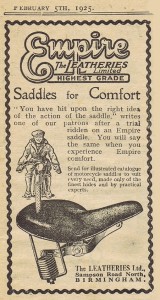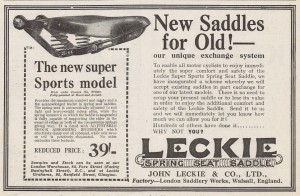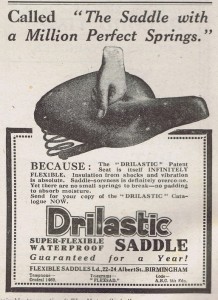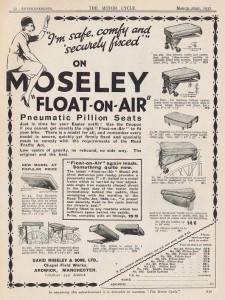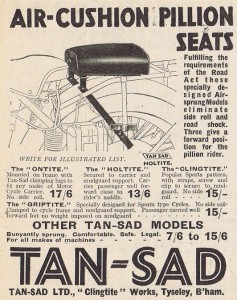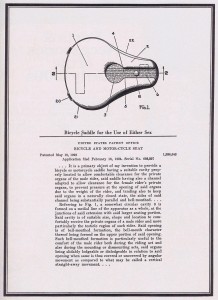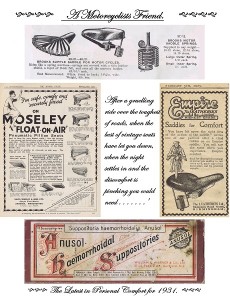As far as modern motorcyclists go we could be regarded as sissies by the old guard when it comes to the comfort of our motorcycles. With longer travel suspension, better shocks, more comfortable seats with thick foam rubber inlays, rubber mounted handle bars and foot pegs we never seem to that happy with what we have and always look for more. Compare that to rigid frame motorcycles from at least 70 years ago with girder (or springer ) front forks, solo seats with mattress springing and very little else we as the “moderns” don’t look that great do we? So as an acknowledgement to our predecessors toughness (there is no other word to describe them really) I have compiled an advertorial display of early magazine advertisements extolling the positives of the manufacturers product.
From the earliest of times seating has always played an important part.
The design and manufacure of seats was quite wide and varied. English motorcycle seats seem to just follow on from the basic cycle or push bike seat, just growing bigger in size. Construction was a steel frame with 2 large suspension springs at the back and mattress springs allowing for a comfortable shaping of the top of the seat for the many different shapes and sizes of posterior. The mattress springing could be the conventional coil type, stretching elastic type, or small leaf spring type arrangement for the lightweight motorcycle. Dunlop produced a moulded reinforced rubber seat cover with less springs in the 1930s, probably relying more on the flexability of the rubber cover. Overall though there seemed to be very little advancement by the english manufacturers to provide more comfort for a ride until the introduction of the foam inlay dual seat of the 1950s. A seat, was a seat, was a seat, so don’t complain! Or perhaps this was due to the fact that english motorcycle manufacturers relied on external suppliers like Lycett, Terry and Brookes for their seats. So what was good for one was good for all.
The Brookes Supple with small leaf springing for the lightweight motorcyle of the late 1920s
Lycetts Aero Elastic Motorycle Saddle – and who said that the stretchy or ‘Bungy Cord’ was a new invention??
Comfort seat covers to make that long ride a little bit more tolerable.
Others keen to enter the motorcycle marketing world.
Unlike their English cousins the Americans seem to have put more thought into the comfort of their ‘derriere’. Early designs were very similar to the english however as time moved on so did their ideas on comfort. Maybe it was as a result of the large distances travelled compared to the quaint english countryside meanders, or perhaps the percieved view that Americans are larger and require more support. Whatever it was I can personally vouch for the comfort of a saddle from an american stead. Guarranteed their seats were larger, but what increased the comfort was the springing. Whereas english machines had 2 suppporting coil springs with very limited travel at the rear of the seat frame american motorcycles like Harley Davidson had a adjustable centre spring that provided longer travel and hence more comfort. At least somebody was thinking more of the new owner. Perhaps another contribution to their comfort was the fact that some of their seats had horse hair as a padding under the leather cover.
Even pillions were thought of with these 2 different versions of the pillion air cushions or seat.
Just click on the pictures to see enlarged versions.
Of course there were the ‘new’ ideas that appeared during the early years that didn’t seem to go far but even though they were serious then they are surely good for a laugh today. Below is such an example.
And then there is the discomfort shared by a few for badly designed seats, mis-shapen, or just worn out seats, and a period medical remedy. Click on the picture below to see what it could be ………
I have left it quite large at 1.9M so you can print it out on light brown card, laminate it and hang on your garage wall.
And as for the suppositories I will leave you to work that out – or in depending on your fancy. Enjoy.
